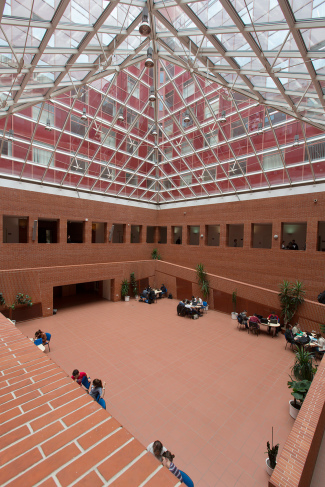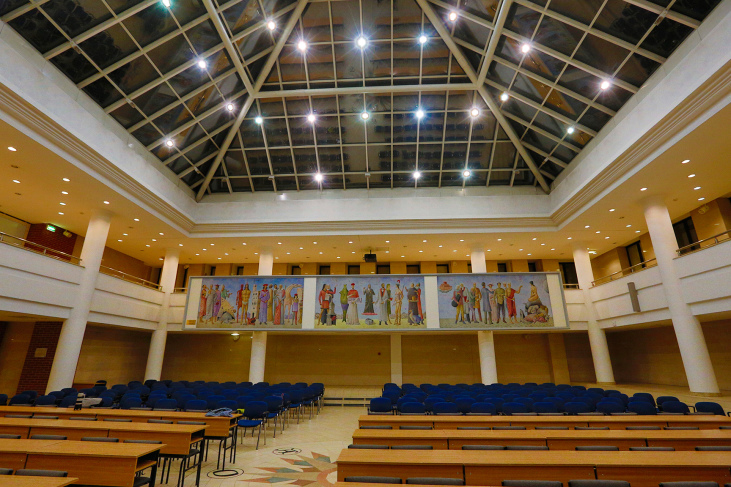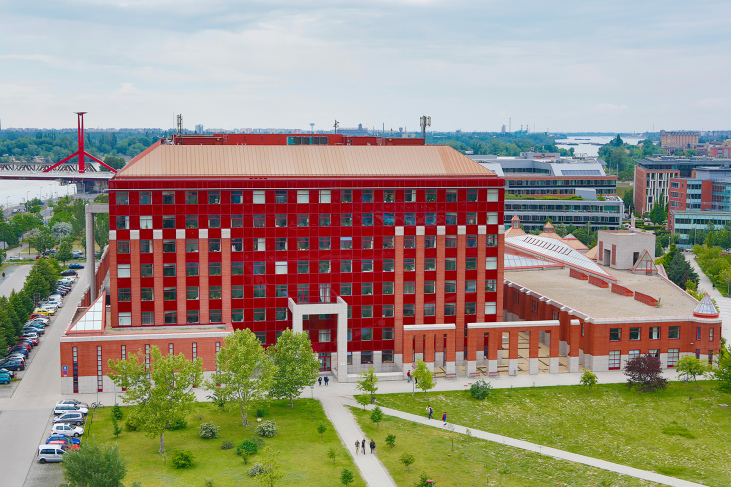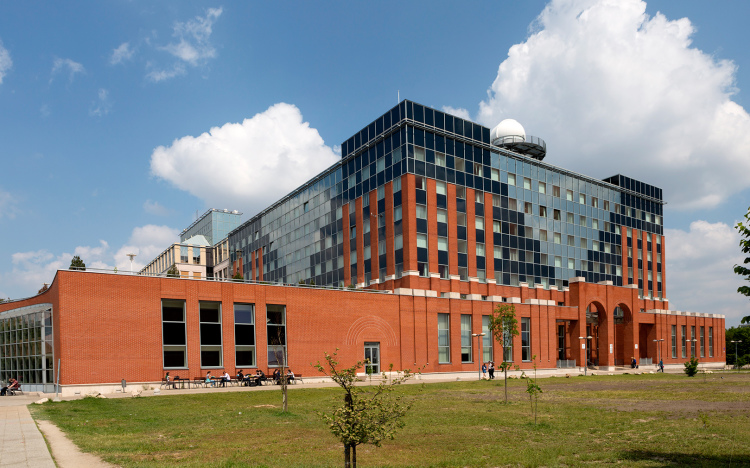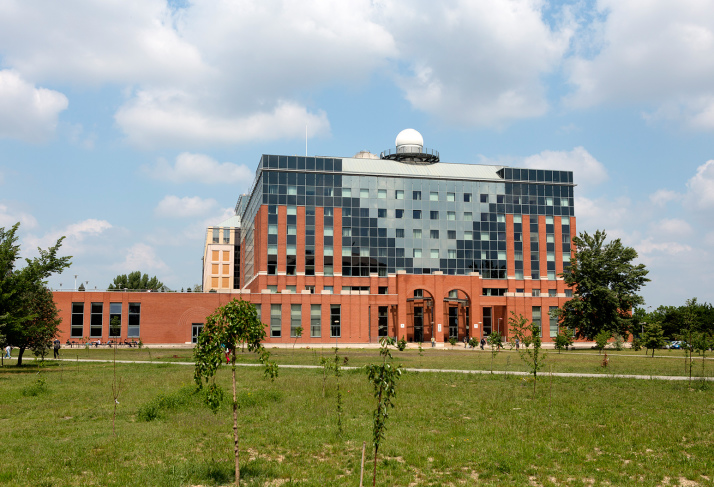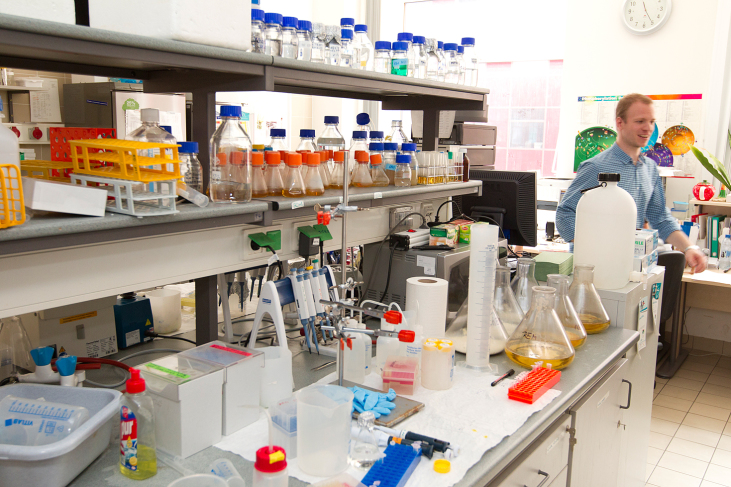Environmental Science MSc
Environmental Science MSc
Environmental Researcher
Degree program
Master
FF/1441-2/2015
Center of Environmental Science
English
4 semesters (2 years)
120
5
20
The Environmental Science MSc program is a complex interdisciplinary research module with environmental awareness.
Our courses are aimed at improving understanding of the environment and the processes that support life on Earth. We are particularly interested in the impacts of human activity in the world around us and in developing ready-to-use approaches for achieving environmental sustainability.
This program is recommended to applicants who want to apply "green chemistry" approach and learn environmental technologies. The main goal is that environmental scientists can identify and address environmental impact assessment and environmental certification.
The Environmental Sciences Master’s degree aims to train researchers having a complex intra- and transdisciplinary vison of the field, nature and environment-centered attitude of mind, and a researchers attitude. The main goal is that the environmental scientists shall be able to identify and manage environmental impact assessment, environmental qualification, to manage environmental science issues from the disposal of waste, through participation in landscape rehabilitation, environmental protection and nature conservation theory and practice, to the accomplishment of environmental problems related to energy resources, environmentally friendly materials and environmental technologies. There is an emphasis on the application of green chemistry approach, and the understanding of the modern environmental technologies. The practice of environmental science has a broad interface with several areas of all of brances of classical natural sciences and in many cases it even overlaps with them. However there are contact surfaces to social sciences too. At the Faculty of Science a very good infrastructure is available, including the practical laboratories concerning all necessary fields of science.
The Faculty of Science, ELTE has expertise in all areas of natural sciences and thus it provides a great study environment for environmental science which is closely linked to classical sciences. Notable books and periodicals and also major infrastructure and laboratory conditions are available at the Faculty of Science, which allows students and researchers to stay up-to-date with new scientific results.
The academic staff have skills and expertise ranging from the smallest scale (sub atoms) to the largest scale (whole Earth systems). They investigate the environment in a holistic manner, integrating a wide range of scientific disciplines and combining basic and applied research.
The Faculty of Science, ELTE has an especially strong tradition of the academic-type training. We work with a wide variety of academic institutions in project and program collaborations and the academic staff members are involved in national and international professional forums and conferences. The Environmental Science MSc program--in line with the social and labour market demands–has a major emphasis on the practical elements of training, but the nature of academic training remains strong, too. Our education strategy, infrastructure and unique combination of cross-cutting scientific expertise enable us to give theoretical and practical knowledge to the students and they can benefit from a sustainable and healthy environment.
Basic courses
The subject is the direct sequel to the B.Sc. subject called Environmental calculations. In the first half of the semester the basic knowledge about data analysis is expanded, with special emphasis put on hypothesis-testing,regression analysis, basics of time series analysis (trend, periodicity, forecasting). Ultimately the handling of missing data and its imputation is learned. In the second half of the semester, multivariate data analysis is the main topic (variance-, cluster, principal component analyses) taught through environmental examples
- Participation of the members of the biota in the environmental changes: general introduction, characteristics of eukaryotes, bacteria, and archaea, differences among the effects of microscopic and macroscopic organisms.
- The effect of the anabolism on the environment. Synthesis of the most common natural polymers. Basics of the decomposition of natural organic compounds and xenobiotics.
- Biochemistry and microbiology in deep-subsurface environments.
- Introduction to soil enzymology. Biochemical and microbiological aspects of the soil – plant interaction. Biochemistry of plant-soil-soil animal-microbe interactions.
- Interaction of the aquatic environment with the atmosphere. Biochemical processes with global effect. - The effects of the catabolic processes on the environment.
...
Students are given advanced-level knowledge on selected topics in ecology deserving the attention of each would-be environmental scientist irrespective of his/her field of specialization. Subjects include ecological consequences of ongoing climate change; global biodiversity patterns; geosphere – biosphere – atmosphere interactions; energy flow and material cycling in ecosystems; historical biogeography; species richness, species composition and spatial patternsin ecological communities; community dynamics; trophic networks and their regulation; ecological guilds; limnology (still and running freshwaters); marine ecology; relationships between biodiversity and functioning of ecosystems; ecosystem services; behavioural ecological grounds of conservation biology; molecular methods i
...
Topics: Quantitative phase analysis by X-ray diffraction Transmission electron microscopy analysis Scanning electron microscopy and electron probe micro-analysis High performance liquid chromatography with dioda array detector Molecule fluorescence spectrometry Measurement of water quality
The radiations play decisive roles in shaping the human environments. The aim of the course is to discuss the main properties of the radiations, to analyze their major properties, their effects to the biological surrounding and the effects for human beings. The course will discuss the ionizing radiations and their environmental characteristics. We shall go through the whole electromagnecic spectrum and even through the corpuscular radiations.
- Introduction Interaction of organisms with their environment (role of physiology), homeostatic processes for thermoregulation, fever
- Muscle and Movement: Muscle structure and function, energetics of locomotion, exercise physiology, cost of transport (swimming, flying, running), control of voluntary movements
- Gas exchange and physiology of ventilation: Respiratory organs, ventilation in aquatic environments, ventilation in amphibians, reptiles, and birds and mammals, regulation of breathing
- Anatomy and physiology of the circulatory system: Fish, amphibians, reptiles, birds, and mammals, hemodynamics, regulatory processes
- Blood components function in exchange, transport and defense. Innate and adaptive immunity, recognition and response
- Food, nutrition, digestion.
...
Knowledge:
History, evolution and types of remote sensing. Passive remote sensing: multispectral scanner technology, CCD technologies. Active remote sensing: radar scanning, radar interferometry, LIDARs, elevation modelling. Satellite orbits and orbit elements. Satellite types. Aerial remote sensing, image ortho-rectification. Interpretation of true color satellite imagery and aerial photographs.
Competences:
Capability of estimation of the order of involved quantities, capability of accomplishing basic geometric computations connected to remote sensing and satellite orbits, ability of choosing the appropriate remote sensing input database for an environmental project
An environment centered unified overview of the planet Earth as a physical system; from the magnetosphere down to the upper zone of the lithosphere. A summary of the external physical influences reaching the Earth. Physics of the interactions between different belts, and their effects on the life system. Effects of short time (environmental level) changes in the physical parameters of different belts. Comparison of natural and artificial (environmental) agents of these changes.
The Applied Hydrogeology introduces students into transientphenomena of groundwaterfluctuations, barometric and tidalefficiency. The course encompasses knowledge on geohydrology and geophysicalmethods of groundwaterresearch. It focuses on groundwaterextraction, pumpingtests (Thiem, Thiem-Dupuit, Theis, Cooper-Jacob methods). The course prepare sstudents for fieldwork in hydrogeology.
Professional core material
Natural and anthropogenic factors of climate change. Radiation processes of atmosphere and surface. Concentrations of atmospheric gases and their changes. Natural and anthropogenic greenhouse effect. Changes of atmospheric ozone concentrations. Climate system. General circulation of atmosphere. Sulphur and nitrogen compounds in precipitation. Acid rain. Role of the oceans and hydrosphere in climate system. Biosphere. Cryosphere. Components of climate system and their interactions. Possible reasons of climate change. Perspectives of global warming. Theory of operation of global climate models, main types. Possibilities and limitations of climate modelling.
This field work takes place right at the beginning of the first semester (the first full week) and is compulsory for all new entrees. The aim of this course is threefold: to strengthen the ability of conscientious moving in the field with environmental issues in focus (as it was introduced during the BSc-level curriculum), to establish a common unified background that can provide a firm basis for the later field sampling course, and to judge the field abilities and connected theoretical knowledge of new students arriving from different institutions with different pre-knowledge to this MSc study. On this basis suggestions can be made to students to enter certain additional brush-up courses.
The actual work is performed in groups of 5-8 students on given complex tasks: careful
...
Role and importance of sample preparation in the framework of analytical strategies and protocols. Separation vs. destruction. Texture, phase, chemistry. Role and importance of separation. Separation techniques for handling solid state samples by physical properties like hardness, grain size, magnetic susceptibility, specific density, surface activity and floating properties. Hands on practices on different environmental materials. Ability to design sample preparation protocols.
Error sources of taking samples. Drafting of speciment. Taking samples from driking-water on the surface, and underneath, bathing-water on the sewage, sediments from surface-waters, sewage sludge, precipitation (rain, snow), sea-waters, sea-water on the surface,sea-creatures and biological speciment. Taking samples from soil (troubled, partially troubled, untroubled). Taking samples from air and athmospherical aerosols, dust in air, settling dust. Samples from metals. Speciment for clinical toxicological examination (blood, bloodplasma, urine, hair, breastmilk). Samples from ford of animal and plant origin. Samples from waste material. Taking samples from industrial materials.
Information content: Mineral phases (solid crystalline compounds) participating or forming in environmental processes – their properties and environmental role. Information types about and characterisation of solid phases (natural or manmade): geometry, texture, chemical composition (major, minor and trace element content, isotopic composition), crystal structural information and the analytical techniques by which one can collect these data. In the first part, attention is focussed on the basic properties of solids (shape, texture, density, cleavage etc.) and from the applicable analytical methods, differential thermal analysis, X-ray powder diffraction and Raman spectroscopy are introduced.
The practical includes the application of analytical methods (introduced within the frame of the lecture) on „unknown” solid study materials (minerals, rocks or manmade materials, e.g., concrete). The students learn to study solids under the stereomicroscope, document them in drawing or photo (with scale), make a detailed and comprehensive macroscopic and microscopic description of the studied material. The students prepare a research report about their study, document the material, the applied analytical methods (analytical conditions, etc.), the results of the analysis, and compare it (wherever applicable) with scientific literature. This way they learn the basics of writing scientific papers. In the first part, focus is laid on the revision of the basic properties of cry
...
Information content: Mineral phases (solid crystalline compounds) participating or forming in environmental processes – their properties and environmental role. Information types about and characterisation of solid phases (natural or manmade): geometry, texture, chemical composition (major, minor and trace element content, isotopic composition), crystal structural information and the analytical techniques by which one can collect these data. In the second part, attention is focussed on more complex and sophisticated analytical methods: X-ray fluorescence spectroscopy (bulk chemical analysis) and scanning electron microscopy, as a method of local chemical analysis (including SE, BE and CL imaging, EDX and WDX analyses) are introduced.
The practical includes the application of analytical methods (introduced within the frame of the lecture) on „unknown” solid study materials (minerals, rocks or manmade materials, e.g., concrete). The students learn to study solids under the stereomicroscope, document them in drawing or photo (with scale), make a detailed and comprehensive macroscopic and microscopic description of the studied material. The students prepare a research report about their study, document the material, the applied analytical methods (analytical conditions, etc.), the results of the analysis, and compare it (wherever applicable) with scientific literature. This way they learn the basics of writing scientific papers.
In the second part, focus is laid on XRF (as a way of bulk chemical analysis), c
...
A considerable fraction of the environmental problems are connected with the huge energy production, which is a prerequisite of sustainable maintenance of human societies. The course deals in details of the energy production methods of human societies. We discuss the basics of the energetic, we explain the energy production methods presently used. It will be pointed out what are the weaknesses of the fossil based energy consumption. The renewable energy production methods will be explained in details. The advantages and environmental problems will be pointed our.
- Sampling of gaseous and soild components from flowing gases.
- Immission sampling of settling aerosols, airborne dusts and gaseous compounds.
- Sampling of surface waters (lakes, rivers), especially regarding the dissolved and particle-bound compounds.
- Sampling of soils and freshwater sediments.
- Sampling of solid wastes.
Information content: soils as complex multiphase systems, soil minerals; rocks, soils and their interaction with industrial processes; solids of the built environment and their transformations (building materials, paints, asbestos, etc.); slags, fly ashes and solid waste materials of fossil fuel plants; industrial byproducts (galvanic sludge, red sludge)
Competences aquired: basic overview about solids in the natural and manmade environment, their general chemical and phase composition, the possible risk related to them / their applicability to environment remediation
The main reasons and consequences of the international environmental crisis; The major environmental contexts of the rapid economic growth and urbanization; Growth in world population and consumption; Sustainable consumption and production, Trends of the international and national environmental policy (overview). Environmental activities of the organizations of the United Nations. The European Union's environmental policy evaluation. The environmental policy analysis and planning basics. The main environmental performance measurement criteria and methods. The green economy and environmental management systems; The concept of urban environment; environmental management and the relationship between municipalities; environmental responsibilities and assets of the municipalities in
...
Sampling from soil, sample preparation for several measurements, like x-ray fluorescence, gamma-spectroscopy.
Sampling from subsurface waters, dissolved radon gas sampling difficulties, comparision of the used procedures. Systhematic uncertainties of the measurements.
Filed measurements of electromagnetic radiation, and 50 Hz electromagnetic field, environmental noise and natural gamma doseintensity. Mapping of environmental parameters.
Measurement of micrometeorological parameters.
The aim of this program is to provide engineers with the necessary knowledge of the , preparation, exploration, production, distribution and utilization of shallow geothermal energy. We also train students in the planning, construction and operation of infrastructure systems and provide the knowledge needed in order to perform engineering tasks. In addition, we aim to supply students with the theoretical knowledge needed for carrying out shallow geothermal systems. Designing of geothermal heat pump systems gain special knowledge in the engineering tasks required of drilling and producing from closed systems and open systems (water wells)
The aim of the lectures is to introduce student to environmental impact assessment and IPPC legacy and application for environmental permission of authorization. It is needed to introduce the system of the national environmental authorities and the procedure of authorization. The goal is also to introduce other special parts of environmental legacy.
Knowledge:
- Structure of the national environmental authorities
- Public administration procedure
- Environmental impact assessment, IPPC procedure and environmental verification
- Leagacy most frequently used in application for permission of authorization and the procedure of the authorization
Skills:
- procedure of the authorization knowing legal background of environmental authorization attitűd:
- Students get insight to en
...
Broadening practical knowledge related to the training via visiting industrial and agricultural facilities.
Specialization in Applied Ecology
- What is conservation biology?
- Biodiversity: concept, definition, measurement and global distribution
- Valuing biodiversity: ecological economics, ethical considerations
- Extinction, and vulnerability to extinction
- Habitat destruction, fragmentation, degradation and over-exploitation of populations
- The problem of invasive non-indigenous species
- Problems of small populations, applied population biology
- Establishing new populations and ex situ conservation
- Designing and establishing protected areas
- Managing protected areas
- The role of not protected areas in biodiversity conservation
- Habitat restoration and ecosystem management
- Economic and legal tools for biodiversity conservation at the local and national levels
- Nature conservation initiative in the European Union
-
Read more »
Field practice, students work in groups of two or three. To investigate various ecological problems / hypotheses, students collect field data, analyze data, draw conclusions, and hand in a report on their work. During this, students obtain the following competences (practical skills):
- collecting field data for ecological research
- sampling animal / plant populations / communities
- analyzing ecological data
- drawing conclusion from ecological measurements
- ecological hypothesis testing
- summarizing research work in report
Specific topics according to the two subdisciplines are as follows.
Plant ecology:
Determination of Leaf Area Index (LAI) in forests; estimation of tree canopy and ground layer plant cover in forests; measurement of tree height and trunk circumference;
...
Purpose of thepractice: biological environment alanalysis, introduction of environment conditions analysis and ecological certification methods; demonstration of basicenvironmentalbiotechnologiesbyplantvisits, comparison of site remediation visits and their laboratory modells
- Monitoring of environment pollution indicators inpolluted surface water / soil / ground-watersystems. Indicatormicrobes, diversity and certification indexes. Ecologicaltests
- Detectionmethods of degradation/elimination of harmful materials by analysis of communalmetabolism
- Applying respirometric methods forestimation of material demolition speed: measurement of biological oxygen demand and metanogenesis. Fitoremediation
- Compilation of sewage modell systems, microbiological and technological
...
- Introduction to microbial ecology. Strain, population, guild, community, ecosystem.
- Metabolic diversity of microorganisms.Chemotrophy and phototrophy, lithotrophy and organotrophy, autotrophy and hetrotrophy, mixotrophy.
- Cultivation based and cultivation independent methods in analyses of microbial communities. Measuring microbial activities in nature.
- Traditional (typological, morphological, biological, evolutionary, phylogenetic) concept of species. Species concept for prokaryotes. Microbial speciation.
- Biogeochemical cycle of carbon. Carbon reservoirs. Photosynthesis and decomposition. Methanogenesis and syntrophy.
- Biogeochemical cycle of nitrogen. Nitrogen fixation, nitrification, assimilatory and dissimilatory reduction of nitrate, anaerobic ammonia oxidation.
-
Read more »
The course provides deeper insight in a few selected topics of ecology, including population interactions and community ecology. During this indoor class, the students prepare reviews of specific fields, learn to plan ecological experiment, learn computer based methods and get familiar with the analysis of ecological data. Some of the tasks are performed in longer block of lessons to provide sufficient time. The students often work in teams of 3-5 person, but they are evaluated based on their individual reports.
Plant ecology part. Students are given an introduction into the most widely used plant ecological research methods such as measurement of habitat microclimate, experimental tools for testing negative interactions between plants (competiton, allelopathy), vegetation
...
- Population dynamics, discere density independent and density dependent models. Chaos in population dynamics
- Continuous population dynamics, dynamics of structured populations
- Predator prey models, The phase space analysis of Lotka-Volterra model.
- The Holling II functional response and the limit cycles in predator-prey dynamics
- Models of competition
- Metapopulations
- Modeling of food webs
Theory
- The origin of landscape ecology, definitions
- Foundation of landscape ecology: concepts arising from the interconnection of contributing disciplines
- Basic concepts in landscape ecology originitaing from ecology: the special interpretation of scale, patterns and processes, context dependence
- Data sources in landscape ecology: biotic data, abiotic background, remote sensing, data of human influemce
- Descriptive landscape ecology: thematic maps, interpretation of remotely sensed dara, landscape history, traditional ecological knowledge
- Landscape pattern analysis: approaches, indices, neutral models
- Modelling in landscape ecology: spatial predictive models, dynamic models, spatially explicit dynamic models
Practicals
- Recognising landscape history from archive
...
Landscape research is an emerging geographical discipline with strong correlation to ecology. This field science comprises descriptive (landscape geography), theoretical (landscape ecology) and practical aspects (landscape conservation and landscape management). Present course primarily focuses theoretical bakcgroud of landcape science with applications.
Landscape geography and landscapoe science includes following topics:
- Introduction: history of landscape science, basic concept of the landscape research;
- Landscape forming processes;
- Patch-corridor-matrix: the land mosaics;
- Patches: categories, structure, functions, metrics of patches, core-edge;
- Boundaries: the concept of ecotones, structures and functions;
- Corridors – general introduction
- Roads - structure and f
...
Landscape research practice is based on the theoretical coure. This practice requires innovative scientific activity by students: students should process a practical or a theoretical topic in field of landscape science. This work comprises studying of original papers (using by science direct and springer liknk), integration of knowledge and making conclusion. Final outcomes of the work is a seminar essay and an oral presentation (10+5 min).
Specialization in Applied Ecology - Optional Courses
- Introduction to human ecology, characteristics of ecosystems. Definitions, biosphere, types of ecosystems, ecological systems, ecological disasters, dynamics and stability of ecosystems, productivity of ecosystems
- Ecological events in the populational levels, dynamics of human populations. Characteristics of populations: population density, birth rate, death rate, structure of populations, age-trees, sexual ration, expected life span
- Population genetics: Hardy-Weiberg rule, mutation, selection, evolution, population dynamics, migration
- Ecological and cultural adaptation, the relationships between man and his environment, human being sin the ecosystems, human adaptation, abiotic factors: light, temperature, air, water, soil, geophysical factors
- Biotic factors: inter- and
...
Pedosphere is an interface between atmosphere and lithosphere. Quality of the mineral and organic phases is an environmental indicator. These properties are essential for several human activities such as agronomy, forestry, environmental analytics, etc… Soils of the World overviews main zonal, intrazonal and athropogenic soils on the basis of WRB regarding correlation between environment and physical and chemical properties.
- Soil classification systems: WRB2006 and WRB2014, US Soil Taxonomy;
- Soils of the high latitudes: Cryosol, Podzol, Histosols;
- Soils of the humid temperate zone: Luvisol, Albeluvisol, Umbrisol; Planosol;
- The grasslands: Phaeozem, Chernozem, Kastanozem;
- The arid and semi-arid areas: Calcisol, Gypsisol Durisol;
- Tropical soils: Acrisol, Alisol, Lixisol,
...
Information content: Environmental problems in the headlines of the news: complex evaluation of environmental problems – aspects of biology, chemistry, materials science and society.
Topics covered:
Environmental problems (e.g., red sludge disaster at Devecser, asbestos plant problem at Selyp, asbestos-bearing hazardous waste deposition in Várpalota, Paks 2 power plant) in the news.
Topics are selected together, then students need to study research papers, make themselves ppt presentations of certain aspects of environmental problems, form a personal opinion on the given problem and wherever possible, offer theoretical solution.
The objective of this course is to establish of knowledge on soil chemistry for master of science (MSc) students, as well as intensification of this knowledge by analyzing and discussing case studies involved soil chemical processes.
- Lecture 1: The solid phase of soils – mineral constituents
- Lecture 2: The solid phase of soils – organic matters
- Lecture 3: Liquid and gaseous phases of soils
- Lecture 4: Solubility equilibria
- Lecture 5: Redox reactions
- Lecture 6: Soil colloids – charge characteristics of soil constituents
- Lecture 7: Adsorption and ion exchange phenomena
- Lecture 8: pH of soils
- Lecture 9: Kinetics of soil processes
- Lecture 10: Case study 1
- Lecture 11: Case study 2
- Lecture 12: Case study 3
With the development of analytical and in general sampling methods, the number and size of environmental datasets are continuously increasing. Therefore during the education of environmental scientists special attention should be paid to teach the students, exactly, how these datasets are obtained and how should these be handled. The main aim of the subject is to show the students, at the beginning of their studies, what are the basic characteristics of these datasets, how ere these obtained, what are the common errors and mistakes related to them and what are the biggest difficulties when it comes to work with them. Moreover the subject want to provide preliminary knowledge for the obligatory „Környezettudományiszámítások” subject.
Main kompentence areas to be develope
...
- Methods of reconstruction in population dynamics in the different periods of human evolution
- The influences of Pleistocen climate pulsation on the origin and differentiation of modern Homo sapiens, the monocentric and policentric model
- The relation of man from historical eras to the natural environment: introduction to environmental archaeology, methods in environmental archaeology
- Reconstructions in environmental archaeology, the controversies in the migrations of different cultures, the harmony of zonal environmental conditions
- Dispersion patterns of paleo-ecological human populations: random, compliant, dispersions of fossils, morphological variations
- Functional (adaptation) bone morphology: diversity in morphological variations, theoretical morphology, structure
...
- Mechanisms of human adaptation, primate, hominid, hominin characteristics of biological evolution, aspects of cultural evolution in human evolution
- Paleoanthropological researches, human ontogeny and phylogeny, introduction to phylogenetics
- Hominida and Pongida evolution in the Miocen era of Africa, the ecological influences ont he early hominida’s biodiversity.
- The origin of human bipedalism, the consequences of bipedalism, the Rubicon limit of brain capacity, the origin of stone tool cultures
- The biodiversity of early Hominida and Australopithecus groups, the morphological definition of Homo genus, the early Homo fossils, Homo ergaster and its contemporaries
- Homo erectus: its body dimensions, Homos from the late-middle Pleistocen era, the neanderthal man and his c
...
After a brief theoretical introduction laboratory and field measurments/investigations will be carried out dealing with the early stages in the life of plants from ovules to established seedlings.
In details: Predispersal hazards (seed losses due to pollination failure, seed losses due to predation, etc). Dispersal (dispersal curves, wind dispersal, endozoochory, epizoochory, myrmecochory, etc). Soil seed banks (seed content of soil, seed longevity, ecological significance of seed banks). Dormancy (ecological significance of dormancy, types of dormancy, dormancy breaking). Seedling establishment (germination experiments, internal and external effects influencing germination success, ecologically meaningful germination experiments).
- Live organisms participate in the alteration of the status of the environment by their metabolism: transformation and use of pollutants in the energetic metabolism; assimilation of pollutants into the biomass; basics of co-metabolism (co oxidation); bioaccumulation and biomagnification. Primary and secondary metabolites as pollutants. The use of these metabolites in environmental biotechnologies.
- The technological basis of the use of microbial activities: biostimulation and bioaccumulation. Local use and global effects.
- Bioaugmentation; immobilized enzyme and cell technologies. Release of GMOs into the environment. Biotechnologies applying suspended or immobilized biomass. Growth curve, kinetics of decomposition processes, toxic effects, biofilms.
- The technology of
...
- Monitoring of pollution indicating microbe communities in case of hydrocarbon-polluted soil/groundwater systems. Interpretation of germ count/activity results.
- Analysis of community metabolism of pollutants. Substrate induced respiration. Analysis of enzyme activities.
- Application of respirometric methods to assess the speed of degradation processes. Comparison of BOD and methane production techniques.
- Assembly of a sewage treatment model system, characterization of its properties. Visit to a Budapest sewage treatment plant.
- Assembly of a composting model system, analysis of basic thermal etc. properties.
- Set-up of microcosm experiments modelling a remediation. Monitoring the microbiota. Visit at a composting plant and remediation site.
The goal of the practical is to
...
Theoretical and methodological introduction
- Introduction to phytosociology and habitat ecology.
- Vegetation history of the Pannonicum floristic province. Basic methods in vegetation science. Systematic discussion of vegetation types Part I. Herbosa
- Euhydrophyte communities including free-floating vegetation.
- Flood swards and related communities. Reed beds, Medium tall waterside communities, Tufted sedge tussocks, Large sedge communities.
- Springs, bogs, mires. Soft water and hard water springs, Transition mires, Raised bogs. Oligotrophic humid grasslands. Purple moorgrass meadows; Humid tall herb fringes.
- Collinar hay meadows. Submontane hay meadows, Humid mat-grass swards, Sub-Atlantic Calluna-Genista heathlands.
- Dry grasslands including grassy rock debris communities
...
Specialization in Environmental Physics
Effects of Earth’s rotation (Coriolis and centrifugal forces), Navier-Stokes equation in rotating reference frames, dimensionless form of equations, Rossby number, Froude number, dynamical pressure, geostrophic equilibrium, Taylor-Proudman theorem, linearization of the equations, wave phenomena in rotating fluids, shallow water equations, conservation of potential vorticity, effects of surface curvature, Ekman boundary layers, upwelling and downwelling, effects of density stratification, thermal wind, Boussinesq approximation, baroclinic instability.
Scope of the course: After review of the basics of acustic theories (waves, their generation, and the laws of propagation) the biological and physiological aspects (human ear, hearing, perceptions) are covered. The topics: characteristics of sonic waves ( types of waves, intensity), spectrum-analysis (Fourier-analysis, noise, tones) are touched. Acustic instruments and noise control procedures are taken into consideration, then insight into sountechnical and diagnostics application is provided.
Theme of the course: Definitions and basic concepts, wave equations and the solutions (chains, strings, vibrating air columns, beams, plates, membranes vibrations); soundsources, acoustic resonator; similarity of sound spaces, types of waves. Dispersion relations, soundspeed, shock
...
Program of the topics: Technologies with conscious environmental protection.
The physical and chemical foundations of the "production" of electrical energy. The instructive model calculations of real-life situations performed with real data helps to introduce the modern energetics and helps the students realize how to create simple mathematical tools to check on the various data displayed in news reports and statements. The basics of nuclear energy: the operating principles of nuclear power plants, the current types and their possible future.
Technologies in overview are arranged in several metrix forms. All metrices consist of technology sequences in the rows and various cross weaving interactions in the columns. In the case of the environmental focus the weaving interactions
...
Aim of the course: Knowledge of advanced measurement equipments and methods used in experimental science at a level of understanding of literature, participation in teamwork, planning and selection of appropriate measurement method allows.
General description of the experimental diffraction methods: amplitude and intensity of the scattered beam. Reciprocal lattice. Bragg condition. Ewald construction. Atomic form factor, structure factor. Systematic extinction. Debye-Waller factor. Bragg scattering, diffuse scattering. X-ray techniques: X-ray sources. X-ray detectors. Absorption spectrometry. X-ray radiography. Single-crystal diffraction. Poly-crystal diffraction. X-ray diffractometer. Qualitative and quantitative phase analysis. Lattice parameter measurements. Determination of
...
Aims:
The Systematics in Materials Science course gives teaching on overview the materials used in everyday life, produced by nature and industry. It gives basic classifications, hierarchy levels of production, analysis and measurement technologies at various levels of organization hierarchy levels. It overviews the basic characteristics based on knowledge collected by using material maps of phases, by cooling, crystallization, tempering, alloying and various modern technologies. The course also gives overview how these materials are utilized in structures, construction. The systematics conatins 3 basic principles in overview: history of matter (evolution), structure and structure investigation of matter, and application of matters in various functions. It clears general
...
- Overview of the occurance of radioactive isotopes in our environment
- The determiantion of the amount of the radioactive isotopes in environmental samples, the basics of gamma-spectroscopy, alfa- spectroscopy, liquid scintillation spectroscopy
- The description of radioactivity, time dependence, differential equations. Natural radioactive series.
- Radioactive equilibrium, uranium series, thorium series.
- The occurance of the members of the uranium series in specific geological environment, poential uranium bearing minerals, radium and uranium migration in geological processes Radon. Dositemry of radon, geological origin of radon, radon in indoor air, radon in caves, and in subsurface waters.
- Radondetectors. Radon diffusion. The radon, as a trace element.
- Electrosmog, Measurements of 50 Hz electromagnetic field of usual devices, spatial distribution of the intensity,
- Batteries useful for storage of renewable energies, chaging and discharging curves, battery charging using solar radiation
- Alpha-radiation measuremetns using liquid scintillation spectroscopy, radium, radon content of water samples
- Beta-radiation, energy spectrum of beta decay, Fermi Kurie plots of Sr and Cs sources.
- Cerenkov radiation, TriCarb device operation in Cerenkov mode, potassium content determination, self absorbtion measurements.
- Gamma-spectroscopy using High Purity Germanium Detectors, natural samples, concentrations of radium, thorium and uranium
- Pozitron Emission, Detecting teh annihilation radiation, and source position determination in a sample.
1. Examination of flow fieldsby PIV method. The PIV (Particle Image Velocimetry) method is one of the most advanced measuring methods which permits the determination of velocity fieldsin a wide variety of flows. Laser sheet illumination produces two-dimensional cuts from the fluid volume, and imaging of small tracer particlesprovides quantitative fluid velocity values and flow directions simultaneously.During this training, students learn how to use the tool and get an insight into the measurement of vortices, and various information obtained by this method.
2. Internal waves along the boundary layer of two fluids. Double layer (fresh water on top of salt water) stratification supports propagating internal waves along the density interface. Such waves are formed by a moving
...
Aim of the course: A practical understanding of advanced measurement equipment and methods used in material science. Independently usage of devices to perform simple measurement tasks. Acquisition evaluation methods. Exercise the report making, metrology and error calculation methods.
Course syllabus: Investigation of mechanical properties I.: elastic and inelastic properties of condensed matter by tensile tests. Investigation of mechanical properties II.: examination of the surface of solids by optical microscope, micro hardness measurement. Calorimetry: measuring the specific heat of solids, phase transitions examination using DSC calorimeter. X-ray diffraction: single- and polycrystalline diffraction methods, determination of lattice parameters, phase analysis. Electron
...
Specialization in Environmental Physics - Optional Courses
Interaction between radiation and matter. Dose concepts, principles of dosimetry and types of dosimeters. Biological effects of radiation. Basic principles of radiation protection.Determination of internal and external dose. Sources of natural and artifical radiation dose. The nuclear fuel cycle and the operation principles of nuclear reactors. Dynamic behavior of nuclear reactors, the problems of controlling the chain reaction, nuclear accidents. Nuclear waste storage and disposal. Safety of the nuclear energy production, trends in inceasing safety and solving nuclear waste problem in the future. Methods and current practice in nuclear environmental control.
Mathematics of waves in general, mechanical waves, waves in the earth, physics of sound, basics Maxwell equations and the electromagnetic waves, low frequency electromagnetic fields, electro-smog, microwave electromagnetic radiations, ionizing radiation
Main goals: description of the structure, turbulence exchange processes and measuring techniques in the planetary boundary layer (PBL). Fundaments of the mathematical modeling of PBL for environmental problems (air pollutions, wind energy resources, etc.)
Main subjects: Structure and daily variation of PBL, governing equations, turbulence, similarity theory in the surface layer and the whole PBL; 1D PBL models, Ekman-layer; turbulence transport of different properties (momentum, energy trace gases), local and nonlocal mixing; structure of the stable and unstable PBL; special PBL-s (above inhomogeneous surfaces, cities, ocean, orography, etc.); PBL - free atmosphere interactions.
Daily variations of trace gases in PBL. Parameterization of PBL and turbulence mixing in numerical
...
Main goals: introduction to micrometeorological processes in the surface atmospheric layer which is the place of human activities and give the practical knowledge for the investigation and planning air quality, human comfort, etc.
Main subjects: Definition and methodology of the micrometeorology. Structure of the boundary layer and the surface layer, molecular and turbulence diffusion, governing equations, principles of the modeling of momentum energy (latent and sensible heat), and mass (vapor, trace gases, aerosol) fluxes, closure hypothesis. Surface energy and water budget. Methodology of the surface layer measurements (radiation, energy budget components, profiles, fluxes). Surface as the initial and final point of the atmospheric cycles of air pollution.
Definition of
...
Pedosphere is an interface between atmosphere and lithosphere. Quality of the mineral and organic phases is an environmental indicator. These properties are essential for several human activities such as agronomy, forestry, environmental analytics, etc… Soils of the World overviews main zonal, intrazonal and athropogenic soils on the basis of WRB regarding correlation between environment and physical and chemical properties.
- Soil classification systems: WRB2006 and WRB2014, US Soil Taxonomy;
- Soils of the high latitudes: Cryosol, Podzol, Histosols;
- Soils of the humid temperate zone: Luvisol, Albeluvisol, Umbrisol; Planosol;
- The grasslands: Phaeozem, Chernozem, Kastanozem;
- The arid and semi-arid areas: Calcisol, Gypsisol Durisol;
- Tropical soils: Acrisol, Alisol, Lixisol,
...
Information content: Environmental problems in the headlines of the news: complex evaluation of environmental problems – aspects of biology, chemistry, materials science and society.
Topics covered:
Environmental problems (e.g., red sludge disaster at Devecser, asbestos plant problem at Selyp, asbestos-bearing hazardous waste deposition in Várpalota, Paks 2 power plant) in the news.
Topics are selected together, then students need to study research papers, make themselves ppt presentations of certain aspects of environmental problems, form a personal opinion on the given problem and wherever possible, offer theoretical solution.
The objective of this course is to establish of knowledge on soil chemistry for master of science (MSc) students, as well as intensification of this knowledge by analyzing and discussing case studies involved soil chemical processes.
- Lecture 1: The solid phase of soils – mineral constituents
- Lecture 2: The solid phase of soils – organic matters
- Lecture 3: Liquid and gaseous phases of soils
- Lecture 4: Solubility equilibria
- Lecture 5: Redox reactions
- Lecture 6: Soil colloids – charge characteristics of soil constituents
- Lecture 7: Adsorption and ion exchange phenomena
- Lecture 8: pH of soils
- Lecture 9: Kinetics of soil processes
- Lecture 10: Case study 1
- Lecture 11: Case study 2
- Lecture 12: Case study 3
With the development of analytical and in general sampling methods, the number and size of environmental datasets are continuously increasing. Therefore during the education of environmental scientists special attention should be paid to teach the students, exactly, how these datasets are obtained and how should these be handled. The main aim of the subject is to show the students, at the beginning of their studies, what are the basic characteristics of these datasets, how ere these obtained, what are the common errors and mistakes related to them and what are the biggest difficulties when it comes to work with them. Moreover the subject want to provide preliminary knowledge for the obligatory „Környezettudományiszámítások” subject.
Main kompentence areas to be develope
...
Aims: The Applied physics: Synthesis course gives teaching on overview the materials structure and mutual relations between the strutural hierarchy levels. Introducing basic principles of separation and rebuilding, the principle of process-description by changes according to the stages observed. Hierarchy levels of disciplines are connected as systems considering various cross sections of Erath, biosphere, geological actors, chemistry structural levels and life-holding units. Connected hierarchy levels are studies in the soil, in the geological and bio-materials. Measurements are systematized in the frame of hierarchy levels. Material systemetics uses material maps of phases and textures, technology material maps by cooling rate, effects of crystallization, tempering, alloying
...
This lecture is intended for anyone interested in environmental optics, animal and human vision, polarized light and polarization sensitivity, including biologists, physiologists, ecologists and physicists. In particular, the recent advances in imaging polarimetry, that translate the parameters of polarization into colour, allow the students to understand the information within the polarization patterns of the optical environment not directly accessible to the human visual system. Such instrumentation has also allowed polarization research to advance rapidly, as we can now glimpse this previously hidden world.
Part I of the lecture deals with the polarization vision/sensitivity in animals and humans. (I.1.) Overview on the historical perspective of polarization vision research.
...
The basic terms of air pollution. The main air pollutants. Emission trends and strategies. Global environmental issues: Stratospheric ozone layer depletion and global climate change. Urban climate. The transport of air pollutants and transformation processes. The diffusion equation and the numerical solution. Transport modells: Gaussian-model, Puff-model, Langrangian and Eulerian models. Optimal choice of location for industrial facilities. International conventions. Measuring systems and instruments.
Basic geochemistry of the Earth and its spheres. Principles of radiogenic and stable isotopes. Brief geochemistry of significant environmental isotopes. Understanding of behave of characteristic environmental isotopes (H, C, O, S, N, He, Li, B, Be, Al, Cl, Si, I, Br, Sr, Rn, Th, U) and their many-fold applications in earth and environmental sciences.
Particle sizing and characterization is an essential for earth and environmental sciences but these techniques are used by petrochemical industry and pharmaceutical industry, as well. This course deals with the most important optical techniques (such as laser diffraction, SLS and DLS, image analysis, etc…) with brief theoretical overview with different kinds of applications:
- Theory: traditional particle sizing (sieving, settling); optical techniques: Mie-theory, Frauhoffer approximation, dispersion techniques, laser diffraction, dynamic light scattering; image analysis;
- Sampling and sample preparation: general application - ISO procedures. Pre treatment for soil and sediment samples: MSZ (Hungarian Standard); Wageningen, USDA and FAO procedures;
- Sizing of particles and a
...
Specialization in Environmental Geology
Information content: Mineral phases (solid crystalline compounds) participating or forming in environmental processes – their properties and environmental role.
Topics covered:
Typical size range of environmental mineralogy: the nanometer-to-micrometer range. Special properties related to the size range (as opposed to the micro- and macroscopic size range). Overview of the applicable analytical methods.
Minerals of the most important natural environments: soils, aerosols, non-consolidated freshwater and sea sediments. Biomineralisation: bacterial precipitates. Mineralogical aspects of waste management and deposition. Remediation of sites contaminated by mining activities. Monument and building conservation, protection of mineral- and rock-based cultural heritage. Minerals o
...
Information content: Systematic mineralogy: most frequent minerals present in the natural environment (50-70 species), their basic mineralogical properties, with emphasis on their environmental roles: minerals with environmental (sulphides) and health risks (amphibole and serpentine asbestos, erionite, quartz), minerals applicable in environmental remediation strategies (zeolites, clay minerals, the rock perlite), minerals transforming under environmental conditions.
Topics covered:
Case studies from Hungarian and international environmental problems (sulphidic ore waste damp remediation, asbestos in the natural and built-in (indoor) environment, asbestos removal, remediation of asbestos mining areas, airborne dusts)
Our currennt physical geographical environment developed during the Quaternary, the latest period of the Earth history. The establishment and future development of knowledge of the process is of prime importance, so within the framework of the course, students learn about the most important phenomena, the most important methods of their research, and the interdisciplinary aspects of the result of these research can be generalized.
- The interdisciplinary approach of the Quaternary (climate, soil forming processes, typical geomorphological phenomenon, sediments). Difficulties of the withdrawal of the boundaries of Quaternary.
- Changes in the vertebrate fauna.
- Changes in molluscs fauna.
- The vegetation changes (pollen analysis).
- The archeology and Quaternary Research.
- Changes
...
In-the-field introduction to certain shallow-penetration geophysical methods used in environmental sciences. Computer based evaluation and interpretation of the measurements and projection of these data to the corresponding target area.
Aim of the course: introduction into the geological built-up and earth-history of the region. Presentation of the most important geological formations.
Main chapters of the course: Geological structure of the Carpathian-Pannonian Region; its major structural units; historical background of the regional research; Old Paleozoic formations; the Hercynian orogeny.
Alpine orogeny; Mesozoic formations; Cenozoic formations;
Quaternary rocks and other sediments; raw materials.
The basic terms of air pollution. The main air pollutants. Emission trends and strategies. Global environmental issues: Stratospheric ozone layer depletion and global climate change. Urban climate. The transport of air pollutants and transformation processes. The diffusion equation and the numerical solution. Transport modells: Gaussian-model, Puff-model, Langrangian and Eulerian models. Optimal choice of location for industrial facilities. International conventions. Measuring systems and instruments.
Specialization in Environmental Geology - Optional courses
Formation and causes of development of urban areas, geographical factors, changes of urban spaces in time, and the latest urban development processes. Factors shaping urban development, urban models, certain parts of urban spaces, their transformation, methods of urban research. Inhabited rural spaces and their general geographical characteristics. Analysis of the interrelations of urban and rural areas. Transition processes of settlement networks.
Basic geochemistry of the Earth and its spheres. Principles of radiogenic and stable isotopes. Brief geochemistry of significant environmental isotopes. Understanding of behave of characteristic environmental isotopes (H, C, O, S, N, He, Li, B, Be, Al, Cl, Si, I, Br, Sr, Rn, Th, U) and their many-fold applications in earth and environmental sciences.
Rocks, ceramics and metal finds in Archaeology. Basic archaeological and museological knowledge.
Methods of analysis of the chipped, polished and ground stones. Provenance of raw materials and technology and scientific/historical implications.
Most important raw materials for stone tools in the Pannonian Basin and its environs. Most important methods of analysis on ceramics. Raw materials and production technology for ceramics and scientific/historical implications. Ores, metals and slags – mineralogical and geochemical characteristics. Metallurgy of the copper, bronze and iron. Modern analytical technology of the metals and slags. Overlook of the history of the use of metals as well as ancient finds in the Pannonian Basin and its environs.
Rocks, ceramics and metal finds in Archaeology. Basic archaeological and museological knowledge.
Methods of analysis of the chipped, polished and ground stones. Provenance of raw materials and technology and scientific/historical implications.
Most important raw materials for stone tools in the Pannonian Basin and its environs. Most important methods of analysis on ceramics. Raw materials and production technology for ceramics and scientific/historical implications. Ores, metals and slags – mineralogical and geochemical characteristics. Metallurgy of the copper, bronze and iron. Modern analytical technology of the metals and slags. Overlook of the history of the use of metals as well as ancient finds in the Pannonian Basin and its environs.
Main goals: description of the structure, turbulence exchange processes and measuring techniques in the planetary boundary layer (PBL). Fundaments of the mathematical modeling of PBL for environmental problems (air pollutions, wind energy resources, etc.)
Main subjects: Structure and daily variation of PBL, governing equations, turbulence, similarity theory in the surface layer and the whole PBL; 1D PBL models, Ekman-layer; turbulence transport of different properties (momentum, energy trace gases), local and nonlocal mixing; structure of the stable and unstable PBL; special PBL-s (above inhomogeneous surfaces, cities, ocean, orography, etc.); PBL - free atmosphere interactions.
Daily variations of trace gases in PBL. Parameterization of PBL and turbulence mixing in numerical
...
Main goals: introduction to micrometeorological processes in the surface atmospheric layer which is the place of human activities and give the practical knowledge for the investigation and planning air quality, human comfort, etc.
Main subjects: Definition and methodology of the micrometeorology. Structure of the boundary layer and the surface layer, molecular and turbulence diffusion, governing equations, principles of the modeling of momentum energy (latent and sensible heat), and mass (vapor, trace gases, aerosol) fluxes, closure hypothesis. Surface energy and water budget. Methodology of the surface layer measurements (radiation, energy budget components, profiles, fluxes). Surface as the initial and final point of the atmospheric cycles of air pollution.
Definition of
...
Modul 1. – Physical Oceanography
The thermohaline (deep water) circulation on presentday Earth, density driven circulation. The definition of deep and surface water according to different principles of science.We track the movement of watermasses along the great conveyor belt, with special emphasis on the Atlantic water masses. The concept of deep water formation is established. The impications of deep water circulation is considered for productivity, pH, TOC, CCD or ACD changes in the three large ocean basins, the Atlantic, the Indian Ocean and the Pacific. Residence time is introduced. Surface water circulation – the force of the wind, Coriolis force and the Ekman spiral and case study in the Arabian Sea.
Modul 2. – Chemical Oceanography
The major constituents of sea w
...
Fundamentals of the interaction of gravitationally controlled groundwater flow systems with sediments and rocks within the sedimentary and diagenetic realm will be presented. The related major chemical and physical processes, their manifestations in various sedimentary environments and the preservational potential of such phenomena in the stratigraphic record will be discussed in the from of seminars. Students must carry out independent literature research on selected topics. Based on the critical review of the relevant papers they present their opinion on the selected topic. Presentations are followed by free discussion.
The goal of this seminar series is twofold: (1) To help the students to acknowledge the role of groundwater as a geologic agent in all near-surface processes
...
The academic subject analyses the connection between nature and society. It examines the changes in environment paradigm., providing a comprehensive historical analysis of the relation of environment and society, focusing on relations of environment attitudes and behaviour.. Major processes: urbanisation, human ecology, Himalaya-challenge, environment-generated migration, ecological interests and their enforcement. Political ecology, the history of green parties and movements. A transdisciplinar examination of environment.
Pedosphere is an interface between atmosphere and lithosphere. Quality of the mineral and organic phases is an environmental indicator. These properties are essential for several human activities such as agronomy, forestry, environmental analytics, etc… Soils of the World overviews main zonal, intrazonal and athropogenic soils on the basis of WRB regarding correlation between environment and physical and chemical properties.
- Soil classification systems: WRB2006 and WRB2014, US Soil Taxonomy;
- Soils of the high latitudes: Cryosol, Podzol, Histosols;
- Soils of the humid temperate zone: Luvisol, Albeluvisol, Umbrisol; Planosol;
- The grasslands: Phaeozem, Chernozem, Kastanozem;
- The arid and semi-arid areas: Calcisol, Gypsisol Durisol;
- Tropical soils: Acrisol, Alisol, Lixisol,
...
The objective of this course is to establish of knowledge on soil chemistry for master of science (MSc) students, as well as intensification of this knowledge by analyzing and discussing case studies involved soil chemical processes.
- Lecture 1: The solid phase of soils – mineral constituents
- Lecture 2: The solid phase of soils – organic matters
- Lecture 3: Liquid and gaseous phases of soils
- Lecture 4: Solubility equilibria
- Lecture 5: Redox reactions
- Lecture 6: Soil colloids – charge characteristics of soil constituents
- Lecture 7: Adsorption and ion exchange phenomena
- Lecture 8: pH of soils
- Lecture 9: Kinetics of soil processes
- Lecture 10: Case study 1
- Lecture 11: Case study 2
- Lecture 12: Case study 3
Information content: Environmental problems in the headlines of the news: complex evaluation of environmental problems – aspects of biology, chemistry, materials science and society.
Topics covered:
Environmental problems (e.g., red sludge disaster at Devecser, asbestos plant problem at Selyp, asbestos-bearing hazardous waste deposition in Várpalota, Paks 2 power plant) in the news.
Topics are selected together, then students need to study research papers, make themselves ppt presentations of certain aspects of environmental problems, form a personal opinion on the given problem and wherever possible, offer theoretical solution.
With the development of analytical and in general sampling methods, the number and size of environmental datasets are continuously increasing. Therefore during the education of environmental scientists special attention should be paid to teach the students, exactly, how these datasets are obtained and how should these be handled. The main aim of the subject is to show the students, at the beginning of their studies, what are the basic characteristics of these datasets, how ere these obtained, what are the common errors and mistakes related to them and what are the biggest difficulties when it comes to work with them. Moreover the subject want to provide preliminary knowledge for the obligatory „Környezettudományiszámítások” subject.
Main kompentence areas to be develope
...
Theory
- The origin of landscape ecology, definitions
- Foundation of landscape ecology: concepts arising from the interconnection of contributing disciplines
- Basic concepts in landscape ecology originitaing from ecology: the special interpretation of scale, patterns and processes, context dependence
- Data sources in landscape ecology: biotic data, abiotic background, remote sensing, data of human influemce
- Descriptive landscape ecology: thematic maps, interpretation of remotely sensed dara, landscape history, traditional ecological knowledge
- Landscape pattern analysis: approaches, indices, neutral models
- Modelling in landscape ecology: spatial predictive models, dynamic models, spatially explicit dynamic models
Practicals
- Recognising landscape history from archive
...
Landscape research is an emerging geographical discipline with strong correlation to ecology. This field science comprises descriptive (landscape geography), theoretical (landscape ecology) and practical aspects (landscape conservation and landscape management). Present course primarily focuses theoretical bakcgroud of landcape science with applications.
Landscape geography and landscapoe science includes following topics:
- Introduction: history of landscape science, basic concept of the landscape research;
- Landscape forming processes;
- Patch-corridor-matrix: the land mosaics;
- Patches: categories, structure, functions, metrics of patches, core-edge;
- Boundaries: the concept of ecotones, structures and functions;
- Corridors – general introduction
- Roads - structure and f
...
Landscape research practice is based on the theoretical coure. This practice requires innovative scientific activity by students: students should process a practical or a theoretical topic in field of landscape science. This work comprises studying of original papers (using by science direct and springer liknk), integration of knowledge and making conclusion. Final outcomes of the work is a seminar essay and an oral presentation (10+5 min).
Particle sizing and characterization is an essential for earth and environmental sciences but these techniques are used by petrochemical industry and pharmaceutical industry, as well. This course deals with the most important optical techniques (such as laser diffraction, SLS and DLS, image analysis, etc…) with brief theoretical overview with different kinds of applications:
- Theory: traditional particle sizing (sieving, settling); optical techniques: Mie-theory, Frauhoffer approximation, dispersion techniques, laser diffraction, dynamic light scattering; image analysis;
- Sampling and sample preparation: general application - ISO procedures. Pre treatment for soil and sediment samples: MSZ (Hungarian Standard); Wageningen, USDA and FAO procedures;
- Sizing of particles and a
...
Specialization in Environmental Analytics
The rapidly increasing worldwide demand for environmentally friendly chemical products and processes requires the application of novel and cost-effective technologies to pollution prevention. Green Chemistry is an emerging new approach focusing on a simple principle: it is better to prevent waste than to treat or clean up waste after it is formed.
Topics:
- The Fundamentals of Green Chemistry
- The Chlorine Controversy
- Replacing Toxic Chemicals
- Alternative Solvents and Reaction Media
- Selective Catalysis
- Asymmetric Synthesis
- Energy and the Environment
- Population and the Environment
- Environmental Economics
- The Environmental Factor in Chemical Research and Development Management
Preliminary knowledges: Basic physical chemistry and thermodynamics, homogeneous , heterogenenous systems, intermolecular interactions, environmental analitical methods and separation techniques.
Course principles: Lectures and laboratory practices cover the fundamentals of colloid science which are required by students of environmental chemistry studying for university degree (MSc).
Brief course summary: Basic principles of colloid stability, preparation and characterization of disperse and cohesive colloid systems are involved. Specific features of macromolecular and micellar colloids, of dispersions with nano-sized particles and also, the interactions relevant in colloid systems are discussed.
Lecture topics: Colloids: definitions, nomenclature, intermolecular and
...
Introduction intosinglevariate and multivariatestatisticalanalysis of chemicaldata. Singlevariatestatistics, distributions, statisticalparameters, definitionsinanalyticalchemistry, tests. Multivariatedatastructures, datavectors. Clustering and classification. principalcomponentanalysis. Modelling. OLS regression. Biasedregression. Partialleastsquares. Robust regression. Nonlinearregression. Analysis of variance and covariances. design of experiment.
Principles of Gas Chromatography (GC). Instrumental setup: carrier gases, injection techniques, types of GC columns, stationary phases in GSC and GLC. GC detectors (FID and EC). General properties of detectors. Qualitative and quantitative analysis. The significance of Kovats Retention Indices in qualitative GC analysis. Calibration methods: external and internal standard methods. Derivatization in GC. Principles of Electron Ionisation mass spectrometric detection. Electron source and fragmentation pattern.Types of analyzors and vacuum devices. Principles of SPE sample pretreatment technique. Organic micropollutan measurements by GC-MS from waste -, river and drinking water samples.
Competences:
Students have a good grounding in the core areas of chemistry (inorganic, organic,
...
- General description of chromatography processes based on the course of separation forces and the mechanism of separations.
- Definition of retention time (tR), adjusted retention time( t’R), partition coefficient (K), capacity factor (k), selectivity factor(α), efficiency (measured by the theoretical plate number N), theoretical plate height (H) and resolution (Rs).
- Van Deemter’s equation and plot.
- Principles of Adsorption-, Ionexchange- (IEC) and Ion- (IC)- chromatography; stationary- and mobile phases (eluent’s strenght), mechanisms of separation.
- Principles of Gel Permeation (GPC or SEC) and Affinity Chromatography (AC): stationary- and mobile phases, mechanisms of separation.
- Principles of Paper- and Thin Layer Chromatography (TLC). Capillary action as the drivin
...
Major objectives: to understand and apply the knowledge presented in the course in solving various problems in the atmospheric environment, and to help students to integrate the environmental approaches into other branches of natural science.
Topics covered: health effects of air pollution, formation of aerosol particles, atmospheric nucleation, cloud condensation nuclei, water vapor in the air, indoor air quality, mass size distribution of aerosol particles, number size distribution of aerosol particles, carbonaceous aerosol, climate change and the air pollution, footprint of atmospheric pollutants.
Formation and chemical characterization of soils. Analytical methods for determination of industrial contaminants of soils, sediments and surface waters. Monitoring methods. Remediation of polluted soils, phytoremediation. Wastewater treatment technologies. Protection of drinking water reservoirs. Biological and chemical methods of water quality measurements. European Directives of Water Quality.
Introduction of the chemical composition of the atmosphere; presentation of the properties, transformations and atmospheric roles of the major atmospheric components (gases and aerosol particles). Atmospheric budget of sulfur, nitrogen and carbon compounds. Formation of ozone and the composition of precipitation water.
Historical review about quality contol and quality assurance systems. Comparison of ISO 9000 and ISO 17025 systems, quality cycle in case of testing laboratory. Quality management, quality audit. Characteristics of an analytical method, sampling and evaluation procedures. Standard operation procedures, validation. Equipment maintenance, calibration, training. Authorized personnel descriptors. Examples of proper use and preparation procedures of certified reference materials.
The objective of the Food Analysis laboratory practices is to introduce students to the basic Analytical chemistry methods used in Food Analysis (i.e., titrimetry with instrumental end point indication, UV-Vis spectrophotometry, thin layer/liquid/ion chromatography) for food sensory evaluation, determination of major (i.e., Krebs cycle acids, alcohol, carbohydrates, unsaturated fatty acids) and minor food (i.e., trace elements, halides, food preservatives) components in basic foodstuffs and commodities such as: egg, eggshell, milk, bread, vegetal oils, curing salt as well as hedonic products such as chocolate, wine, candies, chewing gum, fruit juices.
Weekly schedule:
- Safety and fire instructions in the laboratory.
- Food Sensory Evaluation: distinguishing between the four
...
Specialization in Environmental Analytics - Optional courses
Course principles: Introduction into the bioinorganic chemical approach and explanation of chemical, biological, biochemical, and medical questions by considering these different aspects. Demonstration of the multiple connection of geological and biological environment. Presentation of the role of essential and toxic elements in the living organisms on molecular level. Brief course summary:
Development of bioinorganic chemistry. Biochemical evolution: the effect of primeval atmosphere to the biochemical evolution of copper and iron. Summarized presentation of the role of elements in biological systems. Interaction of geological and biological environment; uptake of elements. Bioinorganic chemistry of essential (Na, K, Mg, Ca, Fe, Mn, Co, Cr, Ni, Cu, Zn and Mo) and some
...
Pedosphere is an interface between atmosphere and lithosphere. Quality of the mineral and organic phases is an environmental indicator. These properties are essential for several human activities such as agronomy, forestry, environmental analytics, etc… Soils of the World overviews main zonal, intrazonal and athropogenic soils on the basis of WRB regarding correlation between environment and physical and chemical properties.
- Soil classification systems: WRB2006 and WRB2014, US Soil Taxonomy;
- Soils of the high latitudes: Cryosol, Podzol, Histosols;
- Soils of the humid temperate zone: Luvisol, Albeluvisol, Umbrisol; Planosol;
- The grasslands: Phaeozem, Chernozem, Kastanozem;
- The arid and semi-arid areas: Calcisol, Gypsisol Durisol;
- Tropical soils: Acrisol, Alisol, Lixisol,
...
Information content: Environmental problems in the headlines of the news: complex evaluation of environmental problems – aspects of biology, chemistry, materials science and society.
Topics covered:
Environmental problems (e.g., red sludge disaster at Devecser, asbestos plant problem at Selyp, asbestos-bearing hazardous waste deposition in Várpalota, Paks 2 power plant) in the news.
Topics are selected together, then students need to study research papers, make themselves ppt presentations of certain aspects of environmental problems, form a personal opinion on the given problem and wherever possible, offer theoretical solution.
The objective of this course is to establish of knowledge on soil chemistry for master of science (MSc) students, as well as intensification of this knowledge by analyzing and discussing case studies involved soil chemical processes.
- Lecture 1: The solid phase of soils – mineral constituents
- Lecture 2: The solid phase of soils – organic matters
- Lecture 3: Liquid and gaseous phases of soils
- Lecture 4: Solubility equilibria
- Lecture 5: Redox reactions
- Lecture 6: Soil colloids – charge characteristics of soil constituents
- Lecture 7: Adsorption and ion exchange phenomena
- Lecture 8: pH of soils
- Lecture 9: Kinetics of soil processes
- Lecture 10: Case study 1
- Lecture 11: Case study 2
- Lecture 12: Case study 3
With the development of analytical and in general sampling methods, the number and size of environmental datasets are continuously increasing. Therefore during the education of environmental scientists special attention should be paid to teach the students, exactly, how these datasets are obtained and how should these be handled. The main aim of the subject is to show the students, at the beginning of their studies, what are the basic characteristics of these datasets, how ere these obtained, what are the common errors and mistakes related to them and what are the biggest difficulties when it comes to work with them. Moreover the subject want to provide preliminary knowledge for the obligatory „Környezettudományiszámítások” subject.
Main kompentence areas to be develope
...
Interaction between radiation and matter. Dose concepts, principles of dosimetry and types of dosimeters. Biological effects of radiation. Basic principles of radiation protection.Determination of internal and external dose. Sources of natural and artifical radiation dose. The nuclear fuel cycle and the operation principles of nuclear reactors. Dynamic behavior of nuclear reactors, the problems of controlling the chain reaction, nuclear accidents. Nuclear waste storage and disposal. Safety of the nuclear energy production, trends in inceasing safety and solving nuclear waste problem in the future. Methods and current practice in nuclear environmental control.
The basic terms of air pollution. The main air pollutants. Emission trends and strategies. Global environmental issues: Stratospheric ozone layer depletion and global climate change. Urban climate. The transport of air pollutants and transformation processes. The diffusion equation and the numerical solution. Transport modells: Gaussian-model, Puff-model, Langrangian and Eulerian models. Optimal choice of location for industrial facilities. International conventions. Measuring systems and instruments.
Thesis
Students directly participate in research and development tasks. Our graduates work with government and other public-sector bodies, agencies, voluntary societies, academia, industry and commerce – nationally and internationally. They participate in landscape rehabilitation, environmental protection and nature conservation and are also able to solve environmental problems related to energy resources, engage in environmentally friendly materials, and environmentally friendly technologies.
-
Environmental inspector;
-
CEO in Paper Reuse Facility;
-
Waste Management Leader in Automotive Industry
4,190 EUR
4,190 EUR
160 EUR (non-refundable)
160 EUR (non-refundable)
4,190 EUR
160 EUR (non-refundable)
Yes
01, Sep, 2025
31, May, 2025
No
Entry requirements
Bachelor degrees in the fields of Environmental Science, Agricultural Environmental Management Engineering, Nature Conservation Engineering, Environmental Engineering can be accepted.
Additionall, Bachelor degrees in the field of Biology, Physics, Earth Science, Biochemical Engineering, Chemical Engineering, if the applicant has at least 80 ECTS credits in the following fields: natural science, engineering, environmental science and environmental economics.
Language requirements
An internationally accredited language examination is required with at least a B2 CEFR level or equivalent result.
Examples of minimum level accepted:
TOEFL iBT 72 pts
IELTS 5.5
Alternatively, an official certificate issued by the applicant’s previous higher education institution can be accepted, stating that the applicant’s previous education (Bachelor’s degree) was completed entirely in English.
| Document | Comment |
| Online application form | - |
| Bachelor-level degree | - |
| Transcript of records | - |
| CV | - |
| Motivation letter | - |
| Copy of the main pages of the passport | needs to be valid |
| Passport photo | - |
| Copy of application fee transfer | - |
Relevant bachelor degree in any field of natural sciences. Applicants still pursuing their BSc studies should obtain the diploma, or at least a certificate of being entitled to the diploma, before starting their MSc studies.
The application starts at the online application system. Students need to register in the system, fill in the online application form, upload the required documents and follow the instructions during the application process.
Procedure of the entrance examination:
If the applicant’s previous studies meet the entry requirements, an oral entrance exam will be organized on Skype, based on individual consultation.
Prof. Dr. Károly MÁRIALIGETI
Tamás WEISZBURG
Associate professor
glauconite@gmail.com
+36-1-372-2500/ ext. 8105
International Coordinator
Mr. Péter MOLNÁR
inter@ttk.elte.hu
+36-1-372-2695
More information
Faculty Website
Environmental Science MSc at the Faculty of Science
Environmental Science MSc at the Faculty of Science
0
/
0















0
/
0





